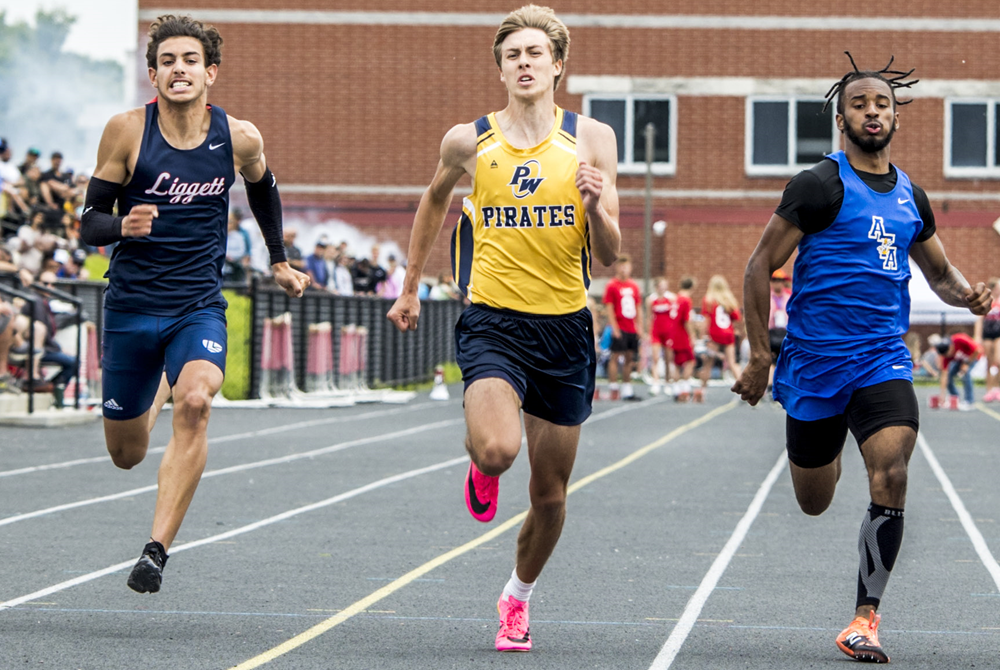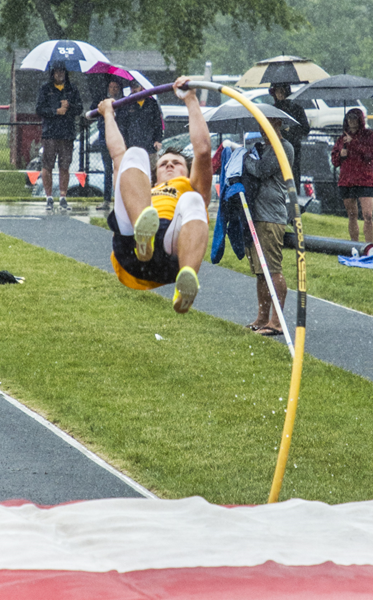
Track Gaining Speed Toward Future with Electronic Starting Devices
By
Steve Vedder
Special for MHSAA.com
May 23, 2023
Aubrey Greenfield thinks it might be the perfect time to reevaluate 130 years of tradition.
For a number of reasons, from technical to personal, the Oxford senior sprinter believes it makes sense for the crack of a starting pistol to be eliminated from high school track meets.
Because track meets would benefit in various ways from lowering costs to easier setup at meets to the human factor of competitors not having to flinch at the crack of a pistol shot, Greenfield believes the sport has a chance to embrace new technology – electronic starting devices (ESD).
In essence, an ESD replaces the starting pistol with a light flash, tone sound or both to begin a race.
"High school sports should put the athlete first," Greenfield said. "We should promote sports, and eliminating starting pistols promotes health in terms of PTSD or trauma for athletes and spectators and that would be good. I would like to think people would say that's a good idea."
In fact, Greenfield would go as far as to say if there was not an implementation of electronic starting devices, many of her teammates would have considered giving up the sport.
"If it's something that helps us compete safely, we're all for it," she said.
Greenfield's opinion apparently is spreading. Michigan High School Athletic Association senior assistant director Cody Inglis said the use of ESD makes it both affordable for meet starters and sensible for athletes and fans to rethink the use of starting pistols. While the MHSAA is not mandating electronic starting devices, it does promote the use of what Inglis calls "emerging technology." He notes that ESD are becoming the norm for organizations such as USA Track & Field, the NCAA and an increasing number of high schools.
 "I think we have to embrace new technology, and we think this will be something that takes hold," Inglis said.
"I think we have to embrace new technology, and we think this will be something that takes hold," Inglis said.
A key part of embracing ESD is the human element. The tragic Oxford High School shooting Nov. 30, 2021, that took the lives of four students while injuring seven others should not be relived even for a fleeting instance at a high school sporting event. Oxford athletic director Tony DeMare said the school began using ESD at every meet, including the MHSAA Lower Peninsula Division 1 Finals last June. He said that decision was embraced by virtually all schools Oxford encountered.
"We were very convinced that the alternative (of ESD) would promote a healthy attitude," DeMare said. "We were overwhelmed with the positive response. If a school was on the fence about it or might not be for it, I think we've started to see the tide turn in favor of people willing to listen and learn about electronic starting devices."
Inglis said the MHSAA is acutely aware of what the crack of a starting pistol can mean to athletes and fans.
"It's unimaginable what Oxford went through, and this is a small way we can help," he said. "We look at a (starting pistol) and think, ‘Could we do something else?’ It's a way of helping to solve a problem."
Over the last several years, the MHSAA has embraced finding an alternative to starting pistols. Inglis noted the discussion started with the cost and diminishing availability of 32-caliber ammunition that meet starters use. A box of ammunition, if it can be found, is around $75 a box.
In addition to cost, there is potential damage from excessive exposure to 150-plus decibels of sound generated by the traditional 32-caliber blanks. Medical studies show damage to ears caused by decibel levels above 120 dB.
The tragedy at Oxford accelerated the conversation.
Inglis said the cost of ESD can be likened to a school sinking money into artificial surfaces at football fields. Yes, there is a great cost at first, but over time money is ultimately saved. An ESD system itself ranges between $200 and $500. Speakers also may need to be purchased, but with ESD starting events like the 800 and 1,600-meter relays positioned near the outside lanes 8, 7, 6 and 5 would result in improved hearing by athletes at the start of a race.
There is one challenge with ESD that track administrators are working to overcome – lighting conditions that lessen the ability to see the ESD’s LED light or strobe when the button is pressed by a starter to begin a race. But that vision difficulty resulting from clear blue skies and backgrounds of setting suns can be substantially improved by incorporating a black background with an ESD – something as simple as a starter holding up black cardboard behind the lighting mechanism at the start of an event.
Inglis said when all factors are considered, the use of ESD makes sense.
 "With the climate we live in nowadays, no lookalike guns is good," he said. "We're not mandating this. But people are saying this is affordable."
"With the climate we live in nowadays, no lookalike guns is good," he said. "We're not mandating this. But people are saying this is affordable."
While switching to ESD would break 130 years of tradition, the timing could be a step forward, said Jeff Hollobaugh, co-author of the book "The Fleet Feet of Spring: Michigan's High School State Championships in Track & Field." He said while no definitive answer is possible, it's likely starting pistols were used at the inaugural state meet at the Jackson Fairgounds in 1895. The meet, which included events like tossing a 16-pound shot put, bike races and a 100-meter sprint, was sponsored by the Michigan Interscholastic Athletic Association (a predecessor to the MHSAA) and comprised mostly of the state's larger schools.
Hollobaugh's sentiments echo what many involved in today's high school track & field believe in terms of making a transition from starting pistols to electronic starting devices.
"It's a change, not necessarily good or bad, just different," he said. "It's not a drastic change, but it will take some getting used to. But it is the future. In the end, we'll all be fine."
DeMare believes the future of high school track will definitely include ESD.
"Our desire is that the practicality and sensibility of this will overcome the alternative," he said. "I think we'll see the automation and electronics taking hold of certain elements in track, and people will embrace it."
PHOTOS (Top) Runners watch official Bertha Smiley as they prepare to begin a race during last season's Lower Peninsula Division 1 Finals at Rockford. (Middle) An electronic starting device provided by VS Athletics was used to start those races. (Below) Smiley sets to begin an event. (Photos provided by David Kuderka/VS Athletics.)

Smith Sets Tone as Multi-Talented Pewamo-Westphalia Ascends Again
By
Dean Holzwarth
Special for MHSAA.com
June 1, 2024
KENT CITY – Trevor Smith set the tone early for the Pewamo-Westphalia boys track & field team Saturday at Kent City.
The junior sprinter earned a narrow win in the 100 to collect early points that would prove beneficial in the Pirates’ pursuit of their latest Lower Peninsula Division 3 championship.
“It was a big win right away in the beginning, and it helped put us in a good position,” Smith said. “It was a big emotional shift, and it was unreal.
“I didn’t really expect it, but it was a big help toward our team with points. I just missed winning last year, so to come back and win it meant a lot.”
Pewamo-Westphalia kept its early advantage throughout and hung on in the end to capture the title. The Pirates, last year’s runners-up, recorded 49 points to clip second-place Clare by four points. Detroit Edison was third with 32 points.
P-W senior Gavin Nurenberg repeated in the shot put (60-02), while senior Collin Farmer added a pair of top-4 finishes in the distance events.
“Our boys had a really nice season, but this was always the focus from Day 1,” Pirates coach Scott Werner said. “We felt we had the pieces in place when we got out of Regionals, and we were just excited to attack the day.
“We are the type of program where we are good in quite a few events. We don't rely on one person. We set the tone early with unexpected points in the 3,200 relay, and it built from there.”
 Farmer finished runner-up in the 3,200 and fourth in the 1,600.
Farmer finished runner-up in the 3,200 and fourth in the 1,600.
“There are not a lot of teams that have good guys in the field, sprints and distance, so I think that brings a lot of peace to the team,” Farmer said. “We knew that we could trust each other, and not one person had to take control.”
Senior Dalton Brown also provided a lift with a personal record en route to a third-place finish in the shot put.
“I challenged each of the separate groups to go out and score a minimum of 15 points,” Werner said. “We had a plan and an approach for every single event, and they trusted the process and executed at the highest level. I’m proud of them.”
Clare made a late push with a strong showing in the relays, while also receiving a boost from senior Brad White. He cruised to a win in the 800 with a new personal-best time and also was part of the winning 1,600 relay.
“Honestly, I didn't expect this,” White said. “I came into today pressure-free. I’ve already accomplished everything I could ever want in a season, and I'm just as happy as I can be to come out here and do something special, especially in my last high school race. I’m proud of my team and my PR.”
North Muskegon senior Jerry Wiegers repeated in the 400 by edging Geoffrey McBurrow of Detroit Edison. Wiegers also won the 200.
“There was a lot of pressure (to repeat), and I was worried on the whole ride here that I was going to screw up and I was going to have to hand the title to someone else,” Wiegers said. “But when I finally passed the finish line and I won, I was like, ‘I did this again, in my final year in high school.’ It was a good way to cap off my career.”
Coloma senior Boden Genovese (1,600) and Grayling senior Drew Moore (3,200) won the distance races, and Napoleon senior Holden Van Poppel (110) and Elk Rapids junior Max Ward (300) were hurdles champions. Standish-Sterling (400), Edison (800) and Traverse City St. Francis (3,200) also won relays. Lawton junior Mason Mayne (discus), Ovid-Elsie junior Tryce Tokar (pole vault) and Clare sophomore Conan Weeks (long jump) were other field event winners. Grosse Pointe Woods University Liggett senior Jake Juip (100 and 200), Montague junior Wyatt Fairchild (400) and Perry senior Alec Chapman (shot put) won the adaptive event championships.
PHOTOS (Top) Pewamo-Westphalia's Trevor Smith, center, edges Dearborn Advanced Technology's Cobey Cureton and University Liggett's Santino Cicarella, among others, in the 100 on Saturday. (Middle) Ovid-Elsie's Tryce Tokar attempts a vault amid the rainy conditions. (Click for more from Jamie McNinch/RunMichigan.com.)

